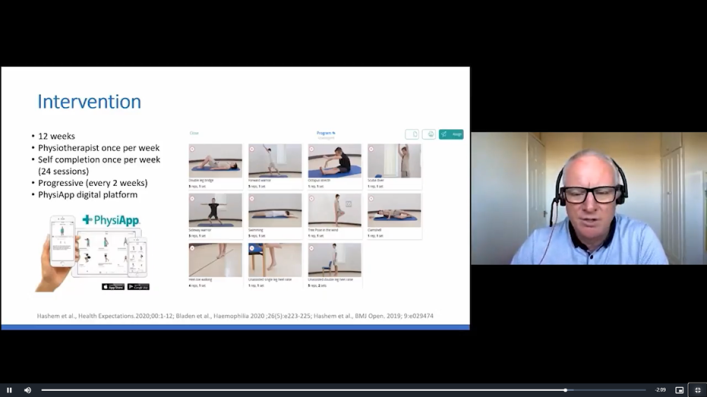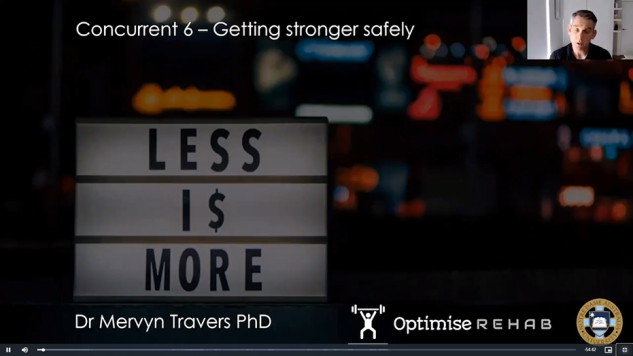JOHANNA NEWSOM
Johanna Newsom is the haemophilia physiotherapist at The Children’s Hospital at Westmead, Sydney NSW
Getting stronger safely
Chair ~ Abi Polus
Research into exercise for boys with haemophilia (DOLPHIN-II Trial) ~ Dr David Stephensen
Less is more – getting the most out of limited time in the gym ~ Dr Mervyn Travers
Panel Q&A ~ Abi Polus, Alison Morris, Tim Demos
As a physiotherapist, for me the concurrent session Getting stronger safely was a highlight of the conference. The two speakers were engaging and clearly passionate about their areas of expertise. Dr David Stephensen is a very experienced haemophilia physiotherapist working in the UK, and Dr Mervyn Travers has a wealth of knowledge and experience in musculoskeletal physiotherapy, particularly promoting physical activity and safe strength training.
David opened the session by telling us about his current research trial (DOLPHIN-II) into exercise for children with haemophilia. It is widely accepted that a well-designed exercise program promotes fitness, strength, agility, balance, and a health body weight, all of which we know is advantageous in people with haemophilia, but astonishingly, there is actual limited published evidence about the benefit of exercise for boys with haemophilia. However, there is good evidence to show the positive impact of exercise in other conditions which cause arthropathies – or joint disease – so it is logical that it would help in this population.

David and his team have designed a long-term study to look at the achievability and acceptance of a regular exercise program, and the effects on strength, participation and quality of life on boys aged 6-12 years with moderate or severe haemophilia. The program is a 12-week progressive design, with regular changes to the exercises to increase challenge (and keep things interesting!). There is a mix of sessions supervised by a physiotherapist, and independent sessions or sessions completed with family members, which are all supported via a digital platform with videos and descriptions of the exercises – very COVID-19 savvy!
Early results are indicating that the program is enjoyed by the boys and their families, easy to stick with, and showing improvements in strength and activity participation. This is an exercise program design that could be easily utilised on an individual or group basis, and could work well with our widespread populations across metropolitan, regional and rural areas as well, so we physios are looking forward to hearing the longer term results and seeing how the improvements are maintained over time… and then planning ways to be able to roll out something similar from our treatment centres.
Merv then gave us an enjoyable and motivating talk about getting stronger safely. He opened with the concept of the human body being ‘anti-fragile’, meaning that when a force (like lifting a safe weight) is applied to our bodies, we don’t break, we don’t just resist the force, but we have the capacity to absorb the force and improve (get stronger) as a result. This is an important idea in haemophilia, where the bleeding disorders community as a whole are still helping the wider population (including teachers and other health care providers) understand that regular exercise and a good activity level is not just safe, but indeed necessary to maintain good musculoskeletal health for people with haemophilia.

An outline of the current recommendations for physical activity broken down by age group then would have had a few of us squirming as we realised we are possibly underdoing our physical activity, especially during our various lockdowns! Merv presented statistics on the average activity levels across Australia and New Zealand, and a massive 30-50% of women, and 20-40% of men are not exercising enough. All exercise should be varied and include some resistance or strength training, balance, and aerobic activity, and be adapted or modified to suit individual ability (your physio or Haemophilia Treatment Centre/HTC can help with that if needed). At a minimum, we should be aiming for:
The subtitle of Merv’s talk was ‘less is more’ and he included lots of tips about how to get the most out of our time spent exercising. He discussed concepts like ‘volume-equated training’ and ‘super-sets’ which can help to get more bang for your proverbial buck when going to the gym, and choosing to don your activewear and lace up your trainers. These concepts need to be cautiously applied to anyone with pre-existing injury or joint damage, and as with any new exercise habit, need to be gradually introduced. Again, your physiotherapist can assist with setting up or changing up your exercise program.
The major take home message from this session on exercise and resistance training is the importance of participating in varied and regular activity, at all ages and stages of life. Exercise is safe for people with haemophilia, with and without existing joint damage, and there are ways to make exercise interesting, challenging and time-efficient. Any new program needs to be carefully and gradually introduced, and your haemophilia team can provide advice and support whenever needed.
Haemophilia Foundation Australia acknowledges the Traditional Owners and Custodians of Country throughout Australia, the land, waters and community where we walk, live, meet and work. We pay our respects to Elders past and present and extend that respect to all Aboriginal and Torres Strait Islander peoples.
Sign up for the latest news, events and our free National Haemophilia magazine